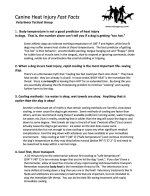It's so easy for dogs to overheat in hot weather. They can't sweat to cool down like us, so they pant instead, but they can very swiftly overheat which can be so dangerous. And I've seen small short-coated dogs collapse from heat -- it isn't just large long coated breeds, any dog can get heat stroke. Here's a good summary on what to watch out for, and how to treat it. The big takeaway is: treat first to cool the dog down, and only THEN take to the vet. And prevention is always better! In hot weather walk your dog first thing in the morning or in evening, when it's cooler. Also: older cavaliers with heart issues can overheat quickly, so be extra careful with activities on hot days.


